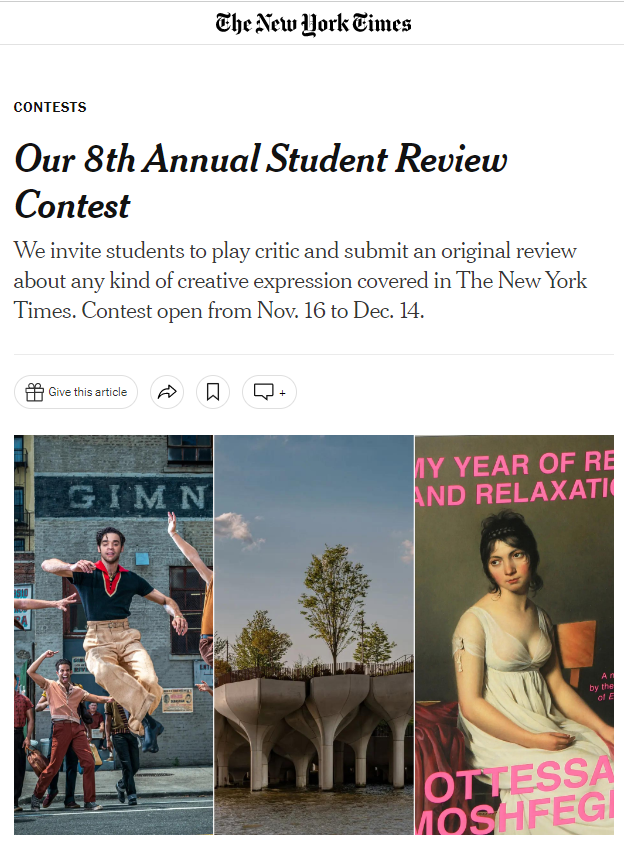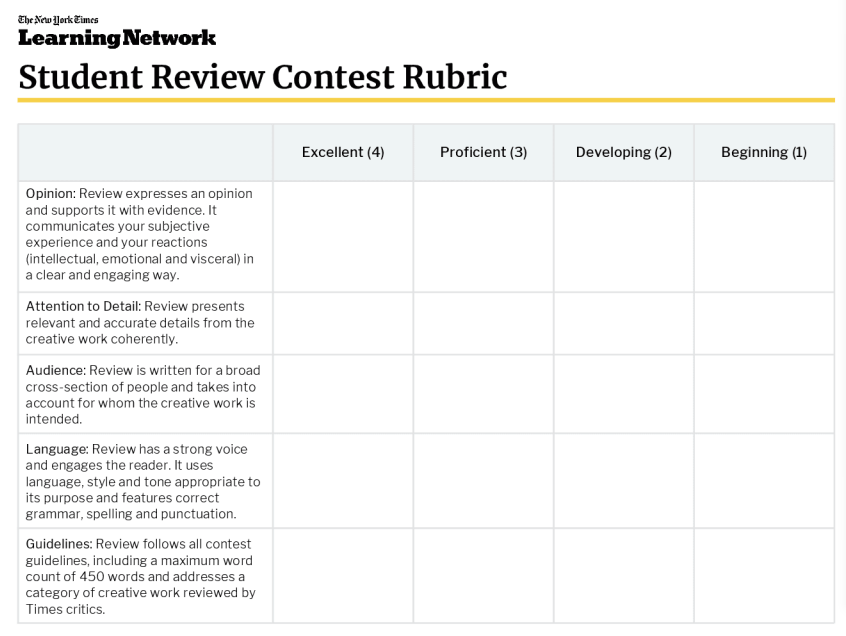优秀范文的阅读与学习是掌握写作技巧的最快方式之一。一篇优秀的文章在主题设置,文章框架,行文方法以及叙事手法上都拥有其突出的地方,值得我们借鉴。
同时,在同学们参与写作竞赛时,阅读这项比赛的获奖优秀范文将帮助同学们理解比赛要求以及评委偏好。
每年纽约时报都会开启学生评论竞赛。对于小作家来说,如果你喜欢对事物发表自己的想法和观点,那你非常适合这个竞赛。
在纽约时报评论竞赛中,学生可以针对任何类型的创意作品进行评论,包括多类别主题。
Aralia特邀名师为大家带来2020年纽约时报第八届学生评论竞赛获奖作品详细逐句分析,帮助同学们感悟获奖作品的魅力,学习优秀写作技巧,助力备赛第一步!

纽约时报学生评论竞赛评分标准

纽约时报学生评论竞赛关注到文章最终呈现的五点内容,并以此作为评分标准,分别是:
Opinion 观点
评论表达了一种观点,并以证据支持它。需要以清晰和吸引人的方式传达参赛者的主观经验及对应反应(理解力、情感和内在)。
Attention to Detail 细节
评论中需连贯地展示了创意作品中相关且准确的细节。
Audience 受众
评论是为广泛分布的人群创作的,需要考虑到创意作品的目标人群。
Language 语言
评论通过强有力的语言叙事来吸引读者。使用适合其目的的语言风格和语气,并具有正确的语法、拼写和标点符号。
Guidelines 比赛准则
评论遵循纽约时报所有的比赛准则,包括最多字数为450字,并根据《纽约时报》评论员所评论的类别进行创作。
并通过四个分值:Excellent (4); Proficient (3); Developing (2) ; Beginning (1)来进行每一项的最终评判。
竞赛评分标准是最好的文章指导和修改准则。通过对竞赛评分标准的解析,有助于参赛者掌握评委的评分偏好,有助于对自己的回复进行适当地修改。
获奖范文在满足竞赛评分标准的同时,又拥有独特的创作思路与行文风格,让我们一起来看看吧~
获奖范文逐段赏析
以下文章来自2020年纽约时报评论竞赛获奖者Samantha Liu的参赛作品, Samantha来自Basking Ridge, N.J.
'Mulan'Remake Won't Make a Fan Out of You
“It’s about that time where Disney plunders a richer past for newly mediocre content, and, as of late, ‘Mulan’ is the unlucky victim. Director Niki Caro struggled to bring maturity to a cheeky original. Gone are shirtless Li-Shang scenes, wisecracking Mushu, infectiously upbeat songs; in their place, wuxia themes and sweeping landscapes. But underneath the diversity points for the all-Asian cast and the grandeur of a $200 million budget lies an empty story: forgettable at best, problematic at worst, satisfying nobody.”
名师解析:
文章开篇第一句话就奠定了作者的主旨基调,使用mediocre“普通的、寻常的”以及victim“受害者”等词体现出了作者对于迪士尼新翻拍的电影《花木兰》的个人态度。
紧接着,作者运用排比的修辞手法将电影中突出的几个点陈列了出来,使得不熟悉此电影的读者也有了初步的了解。
“Though the remake’s omissions from the original imply somberness, its jolts of absurdity found me balking. In the climactic battle scene, Mulan flings aside her protective armor — flamboyant, maybe, but a bit too ludicrous for an adult film. The juvenility doesn’t end there: There’s a witch who transforms into a million bats (and still manages to die from an arrow); the sets resemble dollhouses under oversaturated skies; and the gaudy costuming feels plucked from a princess movie counterpart.”
名师解析:
本段的开头运用了让步句,深入表达作者对于此次翻拍并不满意。在论证层面,作者对于并将电影中具体的场景运用鲜明的形容词进行了详细的描述,比如花木兰过于闪耀的战斗场景,以及女巫拥有变身千万只蝙蝠却死于箭下等。
在作者看来,这些场景使得电影较为幼稚化,在此处作者巧妙地运用比喻的修辞手法将玩具屋dollhouse与公主电影Princess movie相比。
“Caro’s slapdash historical references fare no better. As an addition to the original, a fortuneteller describes chi, the Asian medicinal force, except it’s degraded into a super juice of which Mulan drinks too much. Now, already jedi-like and chi-supercharged, she is literally incapable of doubting herself. I found myself searching for the stumbling, determined teenager of ‘I’ll Make a Man Out of You’ and received instead a Spiderman without Peter Parker. Without the 1998 protagonist’s endearing blunders, Mulan becomes as wooden as the staffs with which she trains.”
名师解析:
这一段的开头就点出论点—-这部电影没有完全参照历史依据。作者将原版与新版电影的故事进行了对比:原版中的花木兰更多的是一位“意志坚定”的青年,而现在的花木兰在作者眼里则更像一位武士。与此同时,作者还巧妙地运用了大众熟知的Peter Parker“蜘蛛侠”这一电影深入地论证自己的观点。
“But if the film seems childish for a heavy historical drama, it still fails to spark joy as a family movie. Thanks to ‘authentic cultural representation,’ which is to say, a Google Translate take on Chinese, all of the characters are austere and distant, poor caricatures of Oriental values. The soldiers, devoid of camaraderie, crack two jokes before being abandoned by Mulan altogether (in the original version, she taught the hypermasculine bunch to cross-dress to save the emperor), while the repeated ad nauseam slogan “loyal, brave and true” casts doubt on Disney’s mastery of the show-not-tell principle. Most of all, it was cringe-inducing to watch Mulan’s parents parrot honor over happiness, so stiffly and stereotypically Asian that they cannot embrace their own daughter. In her attempt to create traditional legitimacy, Caro succumbs to the impersonal, Western notions about Asia. The result is a movie without heart, laughter or warmth — a movie without Disney’s trademark.”
名师解析:
作者在本段开头与上一段进行了衔接:上一段讲述的历史原因,作者这一段开头阐述了本剧既没有达到好的历史剧的标准,又没有达到合家欢电影的作用。
作者通过对士兵和花木兰的家人的行为进行了举例,指出导演所展示出的是“西方眼里的亚洲”,同时指出了本电影并没有体现出同类型电影的代表性特征:感情丰富、轻松欢乐以及带来温暖。
“In 1998, the young Hua Mulan gazed introspectively into her mirror and sang, ‘Who is that girl I see / Staring straight back at me?’ If she were glimpsing herself 22 years into the future, doomed by future Disney’s obsession with garbled live-actions, she would be asking the same question.”
名师解析:
作者在结尾段运用了非常吸引人的设定(“原版中的花木兰”盯着镜子中的自己所唱的歌词)来提出反问,使用讽刺的写作手法再次来指出新版的失败,展现了作者强烈的个人观点。
原文链接:https://www.nytimes.com/2021/03/24/learning/the-winners-of-our-sixth-annual-review-contest.html
范文总结
纽约时报官方给出的评分标准中包含:Opinion 观点、Attention to Detail 细节、Audience 受众群体、Language 语言、以及Guidelines 比赛准则。
在本篇文章中,作者清晰鲜明并坚定地阐述了对于《木兰》这个电影的观点。
作者在整篇评论中运用了非常多的细节描述来强有力地支撑论点。同时,作者在文章中点出导演的名字,以及对于作品的熟悉度都能体现出作者详细的研究以及思考的深度。
此外,在写作叙述上,作者运用了多种倒装句,排列以及引用,这些都是非常亮眼的写作手法。











